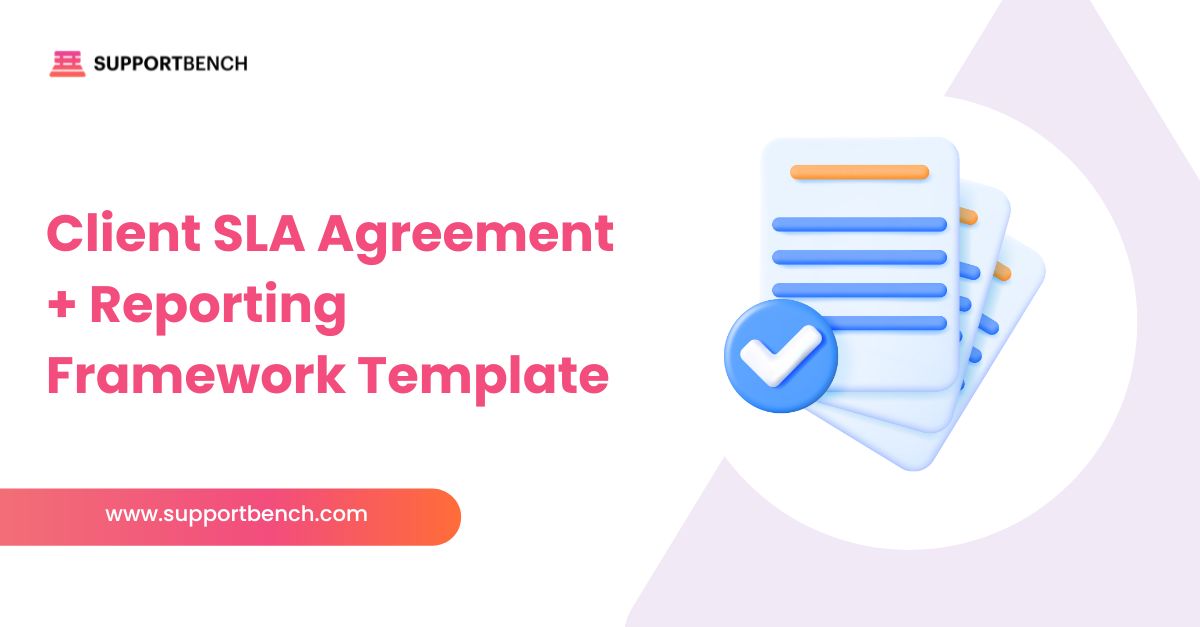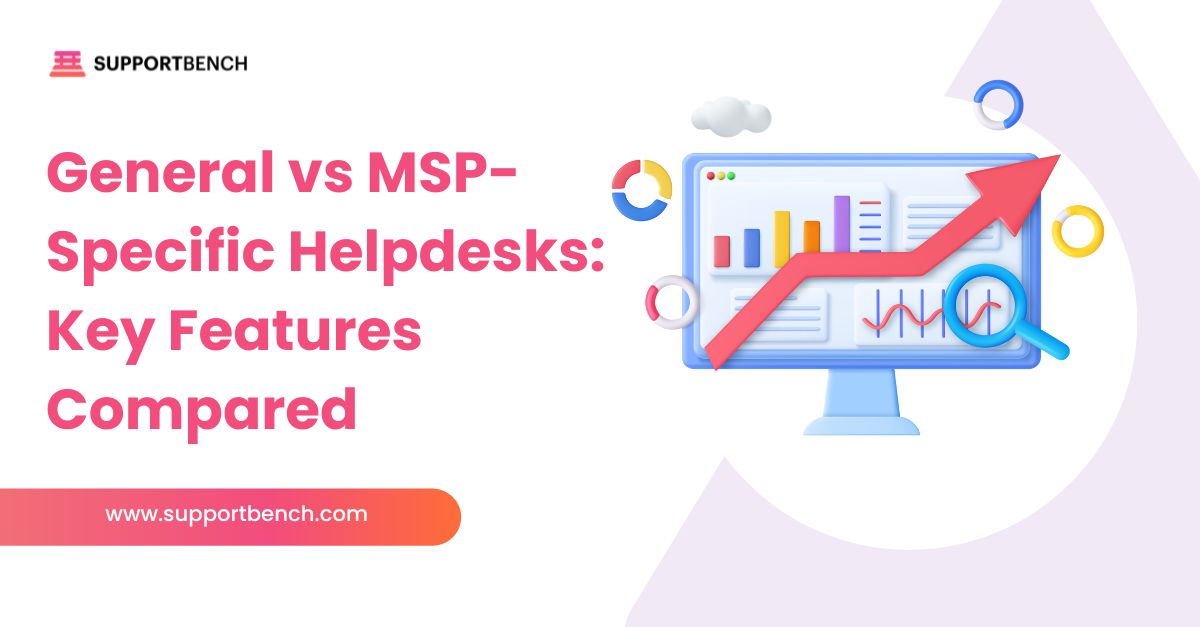For MSPs, SaaS vendors, and IT service providers, success depends on clear, measurable commitments to clients.
Without them, expectations get blurred, issues escalate, and relationships suffer.
A strong Service Level Agreement (SLA) is the foundation for preventing this.
It sets performance standards, defines responsibilities, and provides a measurable way to evaluate service delivery.
At Supportbench, we’ve helped B2B support teams and MSPs design SLAs that don’t just live on paper—they drive performance.
In this post, we’ll share a ready-to-use SLA agreement and reporting framework you can adapt immediately to set clear expectations, ensure accountability, and build stronger client relationships.
Here is the Quick Answer:
Strong client SLAs set measurable service standards and hold both parties accountable. Pair them with a structured reporting framework that tracks uptime, response and resolution times, and client satisfaction. Use automation and dashboards, like those in Supportbench, to ensure compliance, prevent breaches, and strengthen client trust.
What Is a Client SLA Agreement

A Client SLA is a formal contract between a service provider and a client that defines the services to be delivered and the performance levels expected.
It outlines measurable standards, such as uptime, response times, and resolution times, and specifies the roles of both sides.
Unlike internal SLAs, which set expectations within a team, or vendor SLAs, which govern third-party suppliers, client SLAs are outward-facing agreements.
They directly affect customer trust and retention, making them critical in high-touch, business-to-business environments.
The main goals of a Client SLA are:
- Set clear expectations – Define exactly what’s included in the service, when it’s available, and how quickly issues will be addressed.
- Establish accountability – Clarify responsibilities for both provider and client.
- Provide a measurement framework – Use agreed metrics to evaluate performance and spot improvement opportunities.
For example, an MSP might commit to a 99.9% uptime guarantee for a client’s infrastructure, with service credits applied if the standard is not met.
When tied to a strong reporting process, this ensures both transparency and trust.
Key Components of a Client SLA

A well-structured SLA removes ambiguity and ensures both parties share the same expectations.
Here’s a quick reference table of the core elements every SLA should cover:
|
Component Scope Of Service |
What It Covers
Defines the Services Included in the Agreement, Availability Hours, and Any Exclusions |
Example In Practice
An MSP Lists 24/7 Helpdesk Support, On-Site Visits During Business Hours, and Maintenance for Specific Systems Only |
| Performance Metrics | Outlines How Service Quality Will Be Measured, Including Uptime, Response Times, and Resolution Targets |
A SaaS Vendor Commits to 99.9% Monthly Uptime and Responding to Critical Issues Within Two Hours |
|
Reporting Obligations |
Specifies Reporting Frequency, Metrics Included, and Delivery Method to Keep Clients Informed | Monthly Reports Showing SLA Compliance, Average Resolution Time, Escalation Rates, and CSAT Scores |
| Escalation Procedures | Details the Steps Taken if Issues Are Not Resolved Within Agreed Timelines |
A Ticket Overdue by Four Hours Is Escalated to a Senior Engineer and Flagged for Priority Handling |
|
Remedies Or Penalties |
Defines the Compensation or Corrective Actions if SLA Targets Are Missed | Service Credits Issued for Missed Uptime Targets or Free Additional Support Hours |
| Review & Revision Schedule | Sets the Frequency and Process for Reviewing and Updating the SLA |
Semi-Annual SLA Reviews to Adjust Performance Targets or Service Scope Based on Client Needs |
➤ Supportbench Tip: With Supportbench, these SLA elements can be linked directly to automated workflows, triggering escalations, tracking resolution times, and generating real-time compliance dashboards without manual effort.
Why Reporting Matters in SLAs
Clear reporting is what turns an SLA from a static document into an active management tool. Without it, service commitments can drift out of alignment with actual performance.
Here’s why consistent reporting is essential:
- Transparency – Clients gain a clear view of service performance, making it easier to confirm that standards are being met. For example, an MSP might show uptime logs alongside incident explanations.
- Accountability – Regular reports let both provider and client track adherence to agreed targets, highlighting areas for improvement.
- Trust Building – Sharing accurate, consistent data reassures clients that you’re committed to delivering the service quality they expect.
Typical Reporting Intervals:
- Weekly – Useful for high-priority or high-volume environments where issues escalate quickly.
- Monthly – Standard for most SLA reporting; gives a balanced view of performance trends.
- Quarterly – Ideal for strategic reviews and long-term trend analysis.
Key Metrics to Include in SLA Reports:
- SLA Compliance Percentage
- Average Resolution Time
- Escalation Rate
- Customer Satisfaction (CSAT) or Net Promoter Score (NPS)
➤ Supportbench Tip: With Supportbench, these metrics can be captured and visualized automatically. The platform links SLA rules directly to real-time dashboards, so teams see compliance risks before they become breaches.
SLA Reporting Framework Template

A standardized reporting framework ensures consistent and effective communication between service providers and clients. Below is an example SLA reporting template you can adapt to your own needs.
Example Metrics Table
The table below shows a sample SLA reporting format with pre-filled example values.
Use it as a reference when creating your own reports. Replace the example numbers with your actual targets and results to track SLA performance consistently.
|
Metric |
Definition | Target Value | Actual Value |
Status |
|
SLA Compliance Percentage |
Percentage of Requests Meeting SLA Standards | 99% | 98% | Within Target |
| Average Resolution Time | Average Time to Resolve Issues | 4 hours | 5 hours |
Above Target |
|
Escalation Rate |
Percentage of Issues Escalated | 2% | 3% | Above Target |
| Customer Satisfaction Score | Average Client Satisfaction Rating | 4.5/5 | 4.2/5 |
Below Target |
Note: Replace example values with your own targets and actual results to reflect your service performance.
Data Source Reference
Identify and use data sources that reliably track and measure SLA performance:
- Customer Relationship Management (CRM) System: To log and manage service requests.
- Helpdesk Platform: To track ticket creation, resolution, and escalation data.
- Survey Tools: To capture customer feedback and satisfaction scores.
Visualization Tools
Present data in a way that makes trends easy to interpret:
- Charts: Use bar or line graphs to illustrate changes over time.
- Dashboards: Create real-time displays of key performance indicators (KPIs) to keep stakeholders informed.
Sample Reporting Calendar
This sample calendar outlines report submission and review meeting dates for quarterly SLA evaluations.
Adjust the months, due dates, and meeting times to match your client agreements and internal review cycles.
| Month | Report Due Date | Review Meeting Date |
|
January |
5th February | 10th February |
| April | 5th May |
10th May |
|
July |
5th August | 10th August |
| October | 5th November |
10th November |
Adjust the months, due dates, and meeting dates to align with your business cycles or client expectations.
Client SLA Template (Copy or Download)

The following is a ready-to-use SLA template you can copy and adapt for your organization.
It’s based on SLA structures proven to work across Supportbench clients, especially those managing multiple high-priority accounts or strict uptime requirements.
Service Level Agreement (SLA)
Client Name: [Client Name]
Service Provider Name: [Service Provider Name]
Start Date: [Start Date]
Service Description: [Service Description]
Contract Duration: [Contract Duration]
Review Frequency: [Monthly / Quarterly / Annually]
1. Agreement Overview
Defines the services to be provided, the performance standards, and the metrics by which performance will be measured.
Ensures mutual understanding and accountability between the Client and the Service Provider.
2. Roles and Responsibilities
Client: Provides timely access, feedback, and any necessary resources.
Service Provider: Delivers services within agreed timeframes, maintains systems, and communicates clearly on progress and issues.
3. Service Levels
Outlines the specific performance targets for service delivery.
- Response Time: [e.g., within two business hours]
- Resolution Time: [e.g., within 24 hours for critical issues]
- Uptime Guarantee: [e.g., 99.9% monthly uptime]
- Support Availability: [e.g., 24/7 email support, business hours phone support]
4. Reporting and Review
Regular service reviews will be conducted on a [monthly/quarterly] basis.
Performance reports will include uptime metrics, ticket resolution times, SLA compliance rates, and any breaches with corresponding corrective actions.
5. Penalties or Service Credits
If the Service Provider fails to meet agreed service levels, the Client is entitled to [describe penalty or credit structure, e.g., service credits, discounts, or additional services].
6. Termination Clause
The agreement may be terminated by either party with [30/60/90] days’ written notice.
Early termination may occur in cases of repeated SLA breaches or non-performance.
➤ Supportbench Tip: If you use Supportbench, you can link each SLA metric directly to automated escalation workflows and reporting dashboards, making it easier to track compliance in real time and proactively address risks before breaches occur.
How to Customize This Template for Your Business

An SLA is most effective when it reflects your unique services, client expectations, and operational realities. Use these steps to adapt the template:
1. Identify Specific Services
Clearly define the exact services you’ll deliver. For example, specify whether “IT support” includes on-site visits, remote troubleshooting, or both.
2. Set Realistic Performance Metrics
Choose targets you can consistently meet. Overpromising, such as committing to a 100% uptime, can erode trust if it’s unattainable.
3. Define Clear Escalation Procedures
Outline who will handle unresolved issues, how quickly escalations will occur, and what channels will be used for communication.
4. Specify Remedies or Penalties
Document consequences for missed targets, such as service credits, reduced fees, or additional support hours.
5. Schedule Regular Reviews
Plan SLA reviews [quarterly/annually] to ensure targets and processes remain relevant as your business and client needs evolve.
➤ Supportbench Tip: Supportbench allows you to connect SLA thresholds directly to automated workflows. For example, if a ticket approaches a resolution deadline, Supportbench can trigger an escalation path, alert relevant team members, and log the event in the reporting dashboard.
Final Thoughts
A well-structured SLA, paired with a clear reporting framework, is more than just a contract. It’s a living agreement that builds trust, drives accountability, and strengthens long-term client relationships.
When service levels are defined, tracked, and reported consistently, both providers and clients gain the transparency needed to address issues proactively and celebrate successes together.
Supportbench helps teams operationalize SLAs with automated tracking, real-time dashboards, and integrated escalation workflows, turning service commitments into measurable results.
If you’re ready to streamline SLA management, improve client satisfaction, and eliminate manual tracking, it’s time to see the difference purpose-built tools can make.















